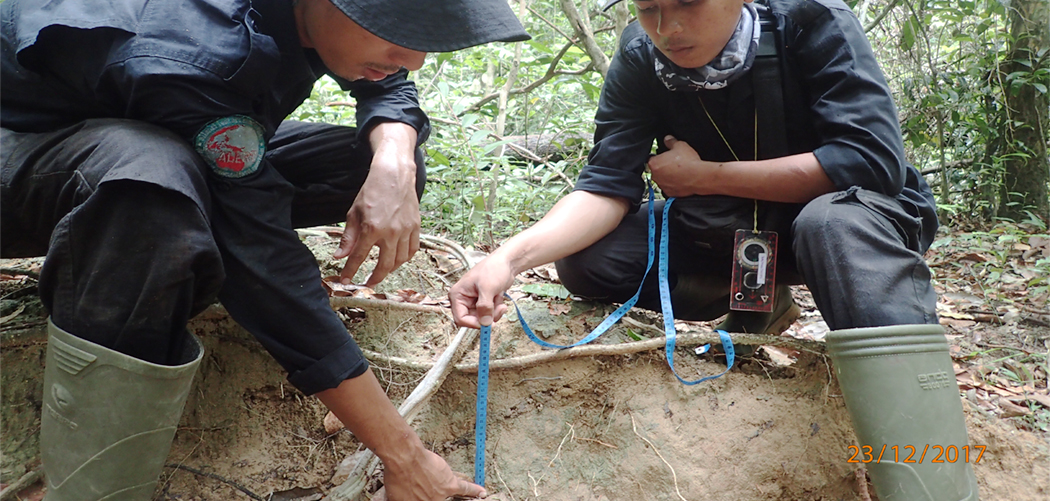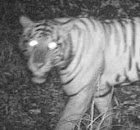The populations of sumatran elephants spread in entire area of Way Kambas National Park. The elephants using the habitat in the southern more than in northern area. The 2nd Reforestation project by ALeRT chose the south side of the Park (sub-section Kuala Penet) who have extensive degraded areas due to forest fires that occur each year.
Degraded habitat occupied more than 40 % area in Way Kambas National Park. Rehabilitation of this habitat condition should be prioritized to provide basic needs of the wildlife including Sumatran Elephant. Habitat rehabilitation also one of long term activity to reducing the level of Human-Elephant conflict that has been recognized as one of Way Kambas National Parks’s biggest problem.
Reforestation site area are divided into 2 cluster. A small 50 hectares cluster is intensive reforestation area, and the big cluster 500 hectares is intensive protection area. For reforestation tree species, we select species by their characteristic and their function. Some of consideration for selecting tree species are:
- Pioneer species and fire resistance,
- Species that benefit for Elephant mainly on providing food,
- Riparian species to be planted on a small stream on reforestation area, good growth and relatively easy to be multiplied on nursery.
These trees never has the chance to grow more than 2 meters because of intensive forest fire on the area. Maintenance of existent trees by reducing competition with imperata grass (cutting the grass) is a very important value to fast reforesting the area for several reasons:
- Many of the existent trees already has a good strong roots and most of them are fire resistance species.
- By our experience on other reforestation project, many of existent trees can grow from 1 meter to be 4 meters within only 2 years of protection and maintenance. Planting new trees (with the same species) only gave maximum 1,5 meter growth within 2 years.
- A fast vegetation cover will suppressing the imperata grass grow and reducing threat of forest fire.
REFORESTASI BAMBANGAN; AREA PERLUASAN HABITAT GAJAH
Populasi gajah menyebar di seluruh wilayah di Taman Nasional Way Kambas. Penggunaan habitat oleh gajah lebih banyak di selatan daripada utara. Kegiatan reforestasi Balai Taman Nasional Way Kambas-ALeRT ke-2 ini memilih sisi selatan (sub-bagian Kuala Penet) yang memiliki wilayah terdegradasi yang luas karena kebakaran hutan yang terjadi setiap tahun.
Habitat yang terdegradasi menduduki lebih dari 40% area di Taman Nasional Way Kambas. Rehabilitasi kondisi habitat ini harus diprioritaskan untuk menyediakan kebutuhan dasar satwaliar termasuk gajah Sumatera. Rehabilitasi juga merupakan salah satu kegiatan jangka panjang untuk mengurangi konflik manusia-gajah yang telah dikenali sebagai salah satu masalah terbesar Taman Nasional Way Kambas.
Are reforestasi dibagi menjadi dua kluster. Kluster kecil seluas 50 hektar untuk area reforestasi intensif, dan kluster besar seluas 50 hektar sebagai area perlindungan intensif. Untuk spesies pohon reforestasi, dipilih berdasarkan karakteristik dan fungsi pohon. Beberapa pertimbangan dalam pemilihan spesies pohon diantaranya:
- Spesies tanaman perintis dan tahan api,
- Spesies yang bermanfaat untuk gajah terutama dalam ketersediaan pakan.
- Spesies Riparian yang dapat ditanam pada sungai kecil di daerah reboisasi, dengan keunggulan yaitu pertumbuhan baik dan relatif mudah untuk diperbanyak dalam pembibitan.
Pohon-pohon ini tidak pernah memiliki kesempatan untuk tumbuh lebih dari 2 meter karena kebakaran hutan yang intensif di daerah tersebut. Pemeliharaan pohon lama dengan mengurangi persaingan dengan alang-alang (pemotongan rumput) merupakan nilai yang sangat penting untuk mempercepat reforestasi karena beberapa alasan, diantaranya:
- Banyak pohon-pohon lama memiliki akar yang kuat dan baik serta kebanyakan dari mereka adalah spesies tahan api.
- Berdasarkan pengalaman pada proyek reboisasi lainnya, banyak pohon lama dapat tumbuh dari 1 meter menjadi 4 meter hanya dalam waktu 2 tahun dengan memastikan perlindungan dan pemeliharaan. Penanaman pohon baru (spesies yang sama) hanya memberikan maksimum pertumbuhan 1,5 meter dalam 2 tahun.
- Penutupan vegetasi yang cepat akan menekan pertumbuhan alang-alang dan mengurangi ancaman kebakaran hutan.









































 Enjoy the Way Kambas National Park endangered mega fauna and other rare wildlife species caught in video. Find mother and baby of Sumatran rhino, challenging young male Sumatran tiger, big family of Sumatran elephant, funny Malayan sun-bear and curious Malayan tapir.
Enjoy the Way Kambas National Park endangered mega fauna and other rare wildlife species caught in video. Find mother and baby of Sumatran rhino, challenging young male Sumatran tiger, big family of Sumatran elephant, funny Malayan sun-bear and curious Malayan tapir. It was written by Janos Olah & Attila Simay in Birding Asia magazine, on 2007. Not only the great variety of the otherwise scarce and hard to-come-by species is what makes this national park world-famous, but also the relative ease in finding them. No other place in sumatra that has 4 species of Frogmouth.
It was written by Janos Olah & Attila Simay in Birding Asia magazine, on 2007. Not only the great variety of the otherwise scarce and hard to-come-by species is what makes this national park world-famous, but also the relative ease in finding them. No other place in sumatra that has 4 species of Frogmouth.





0 komentar :
Post a Comment
Berikan saran atau kritik yang membangun untuk website ini
Terimakasih